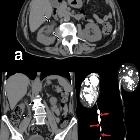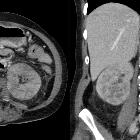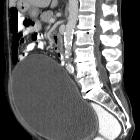Harnwegsinfekt



Urinary tract infection (UTI) is a common clinical condition involving the bladder (cystitis) and kidneys (pyelonephritis). It is commonly divided into 'uncomplicated' and 'complicated' infections.
Clinical presentation
- painful urination
- strangury
- bloody, dark, cloudy urine
- urinary frequency
- urinary incontinence
- urinary urgency
- systemic symptoms: fevers, chills, rigors, tiredness, confusion
Pathology
UTIs occur when there is bacterial colonization of the uroepithelium and a subsequent inflammatory response. Classically, the urine and urinary collecting system were considered sterile, however, there is some debate on whether a small amount of bacterial colonization is normal . Given this, and that voiding urinary samples may be contaminated by skin or rectal reservoir flora, bacteriuria is suggestive of a UTI, but bacteriuria and pyuria (white blood cells in the urine) is much more specific for infection.
Uncomplicated vs complicated UTI
- uncomplicated: an otherwise healthy patient with a structurally and functionally normal urinary tract
- complicated: factors are present that decrease the likelihood of therapy being effective
- urinary tract is structurally or functionally abnormal
- immunocompromised status
- especially virulent pathogen
- factors that may make a patient complicated
- male
- childhood UTIs
- immunocompromised
- pregnancy
- elderly
- diabetes mellitus
- failed antibiotic course
- extended symptoms before presentation
Treatment and prognosis
Uncomplicated
These patients are usually well managed with a course of oral antibiotics.
Many imaging algorithms suggest that imaging for uncomplicated cystitis or pyelonephritis is unnecessary.
Complicated
These patients have often failed a course of antibiotics and may benefit from imaging:
- lower urinary tract
- CT urography: for evaluation of structural abnormalities and possible abscess formation; MRI could be considered if the patient has an allergy to contrast
- ultrasound has a secondary role
- upper urinary tract
- CT abdomen with contrast (or without and with contrast)
- MRI abdomen: for patients with contrast allergies and pregnant patients
- renal and bladder ultrasound: second line, relative to CT it is not as good at detecting renal parenchymal changes and/or characterizing perinephric extension of infection
See also
Siehe auch:

 Assoziationen und Differentialdiagnosen zu Harnwegsinfekt:
Assoziationen und Differentialdiagnosen zu Harnwegsinfekt:







